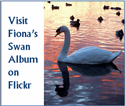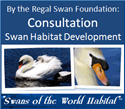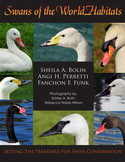Ask the Swan Specialist
Date: 17 March 2012
Hi Tess:
We do not know your temperate zone, so we are not sure exactly what types of plants will grow in your area. You do not want to use any type of plants that are obviously poisonous or attract pests such as ants, flies or bees. If you have a chained link fence, you can even use colored fence slats that will help block too much wind without tearing down the material such as when using windscreen. Windscreen during heavy winds can become detached and whip around the fence, possibly injuring the birds.
If you have a particular bush or tree that you have native to your area and is not poisonous, you can place the bushes on the outside of the fencing. Now, with this said, if trees or high bushes are used around your fencing, these may provide a foothold for predators to climb the fencing and leave your swans unprotected from such predators as raccoons, bobcats, panthers, foxes, etc. So, if you have predators in the area, you may not want to use bushes or trees too close to the habitat fencing on the outside.
The better solution would be us place the trees and bushes inside the fencing a good distance away from the fence so that they cannot be used as a climbing area for predators. Inside the fencing will allow the swans to snuggle under the bushes in extreme weather and will act as a normal nesting and habitat environment for the swans.
We are presently working on our new book which will discuss the design and development of swan habitats to include fencing, landscape and other information related to swan ownership. We are anticipating that the book will be published by May of this year. In the meantime, we are providing you with a listing of some bushes and trees that you can use that are not poisonous.
Magnolia, Palm, Pine, Oak, Poplar or Beech trees. Hawthorn, ligustrum bushes or trees, vibernums, gardenias, etc. can be used, but they may be a little buggy.
Other concerns should be the use of insecticides, pesticides, fungicides, etc. that can poison the birds.
An aerator (below ground bubbler or above ground fountain) should be used to ensure that the pond remains aerated and free from non-oxygenated bacteria which can produce Botulism a toxin that can kill the swans.
Finally, the substrate around the habitat must be considered because gravel, concrete, asphalt or other rocky or hard surfaces can cause a condition called "bumblefoot" in the swans which can cause lesions on the bottom of their feet and difficulty in walking. The swans' entrance an exit from the pond should have a zero entrance so that the swans and any potential cygnets cannot be injured from slipping or falling from rocky or steep banks.
We hope this information helps you with your landscape endeavors. The Regal Swan
Messages In This Thread
- winter shelter -- Tess -- 16 March 2012
- Re: winter shelter -- The Regal Swan -- 17 March 2012
Ask the Swan Specialist is powered by
Tetra-WebBBS 5.30 Beta © 2006-2007 Tetra-Team






